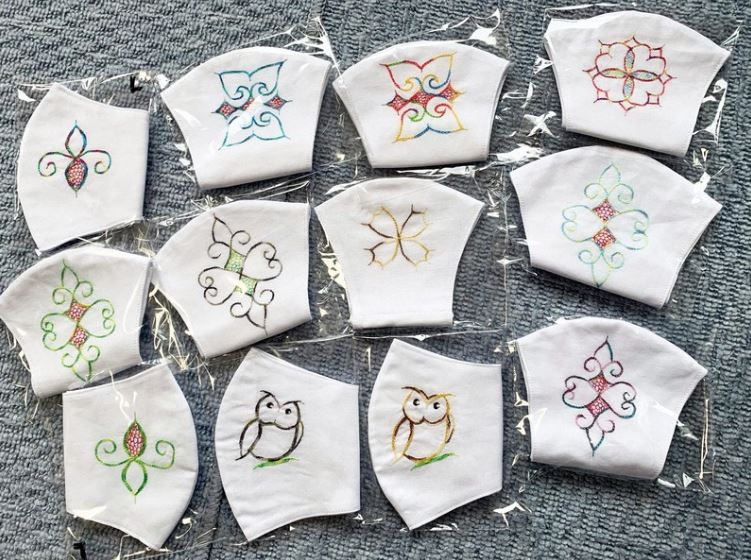
When we entered the year of 2020 six months ago, nobody would have realized that we are in a year-long masquerade in public as part of our new normal to combat novel coronavirus. Rather than wearing masks like the upper classes in 16th century Renaissance Italy to disguise themselves from being recognized, we wear masks for the sake of the safety of public health. In the US, to avoid being stigmatized or mistaken someone unwell, and to prevent the public from stockpiling the already insufficient surgical masks, health officials use “face covering” instead.
Following the rule of simple writing, I find this renaming of a mask unnecessary. Why do we choose a two-word phrase whose meaning is more inexplicit than a simple word mask? An other example similar to that is “result” and “end result.” Doesn’t “result” already convey an outcome? To what end are we expecting for an outcome?
If the public is more receptive to the term “face covering” and they’re more willing to comply with using a mask to cover their mouth and nose, I applaud the regulators. As an amateur linguist, I prefer the one-word usage of mask. Plus, it’s easier to translate mask into multiple languages than explain a mask is a face covering.
Listening to 1970s hit song “This Masquerade,” as the Carpenters sing soulfully: “ … Looking for words to say, searching but not finding understanding anywhere. We’re lost in a masquerade.” I can’t help thinking: Aren’t we lost in a masquerade, too?
A mask, from Middle French masque, means a cover for the face with openings for the eyes and mouth. A false face, from Italian maschera, to hide or guard the face. During the covid months, an Italian company is making transparent facemasks so people can see the wearers’ mouths. The design is mainly for surgical use. The medical providers can communicate with their patients by facial expressions visible through the transparent masks. However, the idea is pretty cool. Perhaps we can try something new for the face-covering masquerade at future Venetian Carnivals.
The pandemic restricts our outdoor activities but also spurs mankind’s ingenuity as we adapt to our new normal. We cannot travel afar without being concerned about how our presence will impact the public health at our destination, and vice versa. But we can travel virtually around the world to see how other cultures are adapting the new normal of mask wearing and social distancing.
Artisans in Asia are thriving with their sewing and embroidery craft. Vietnamese designers embroider face masks with traditional designs. The patterns range from animals to floral or royal motifs. They are all handmade by local women. The community art scene also happens in Japan. Face masks embroidered with traditional designs of Japan’s indigenous Ainu people to ward off evil have gained popularity in Japan. They are worn by governmental rank and file, as high as Chief Cabinet Secretary Yoshihide Suga. The Ainu language in Hokkaido, the northern island of Japan, is critically endangered. The Ainu traditionally practiced animism and had no written language. The eight-member embroidery circle in Hokkaido has taken the opportunity to honor the Ainu culture on the embroidered mask. They can only make about 20 masks a day but they have received orders for 500 masks. Demand and supply is at play.
The world is making two concerted efforts in 2020—finding novel coronavirus vaccines and producing reusable masks. On the vaccine front, the latest research shows that since January, the virus has gone through at least six major gene changes that boosted its ability to infect and evade the human immune system. The rapid mutations of novel coronavirus may have raised a red flag to lab researchers and public health officials that novel coronavirus may be here for a much longer time than anticipated. The vaccine we have tomorrow may not be effective to the mutated virus. China and South Korea both see recurring coronavirus cases after a short period of zero cases. We are seeing the early, middle, peak and recurring stages of infections in different regions, from Africa and India, to the US and Brazil, and to China and Korea. If we agree on the term “end result,” what end are we expecting for an outcome of this voluntary masquerade?
On the mask production front, it’s exciting and even entertaining. With global warming in sight, we’ll have a hotter summer than expected. Wearing a mask on a hot summer day is unthinkable, unless your profession demands you wear a mask. We need to shout out to the essential workers who must work and wear masks during covid months. When we don’t need to wear masks at home, these essential workers are providing us with the services that we need at home. This masquerade is turning to be inclusive. And of course, the global shortage of masks and poor distribution remain.
In northeastern Japan, reusable cloth masks that are refrigerated and sold in vending machines have become popular. In fact, several Japanese companies are developing cool face masks. The cool cloth mask has two pockets to hold four refrigerant packs and can cool the user’s face for up to two hours.
Israeli inventors have demonstrated their brainchildren—a remote controlled mask allowing diners to eat food without taking it off and a self-cleaning mask with heat from a USB port charger. Even the N95 mask inventor Peter Tsai, a retired material scientist and engineer, is responding to a huge demand of N95 masks by returning to his lab to search for a safe reuse method.
Did you catch Mr Tsai’s interview in which he said he felt “obligated to help the industry”? That obligation is a universal calling from socially-concerned citizens. The world will need at least 5 billion masks for this year. That’s a huge economic and environmental burden. Circular economy is the way to go. So is the lifestyle principle of “reduce, reuse and recycle.”
We’re racing against time and the speed of viral mutations to find solutions. While the US public is still debating the legitimacy of tracking infections, and of wearing face covering, we need to simultaneously focus on what we see as being righteous and pursue it, such as the right way to clean our cloth masks. What becomes the highlight of my virtual travel is when East meets West. The headgear worn by the first emperor of China’s Song dynasty was an inspiration for a French artist to make his papier-mâché hat to remind the public of social distancing. Back in the 10th century Song dynasty, the first Song emperor was said to have ordered his officials to wear winged hats so that they could not gossip without being heard. In France 2020, gregarious people enjoy this creative hat fashion to remind themselves to keep three feet (one meter) apart as stipulated in France’s coronavirus regulations.
How about a look of the social distancing shoes invented by Romanian shoemaker Grigore Lup?
While today it’s considered a delicacy, lobster was once a poor man’s food. Yesterday’s masquerade masks for aristocrats and nobles are now for people of all ages and social status. We are experiencing an abnormal time of long-term face covering. From head to toe, with a French papier-mâché hat, myriad choices of designer’s mask, and a pair of Romanian social distancing shoes, any wearer of this attire should be well equipped in this masquerade of 2020.

